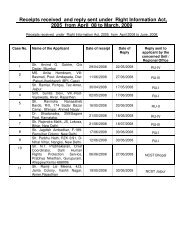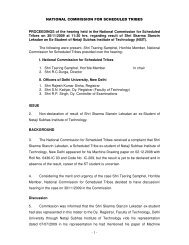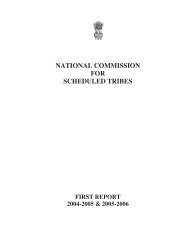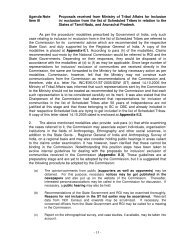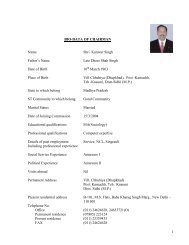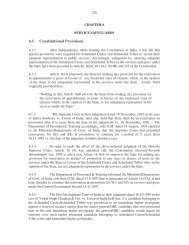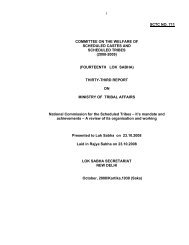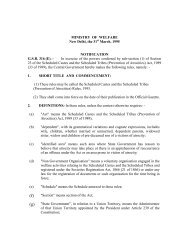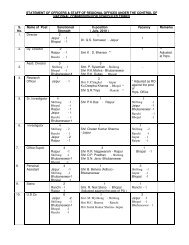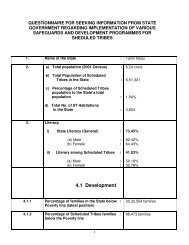Copy - National Commission for Scheduled Tribes - NCST
Copy - National Commission for Scheduled Tribes - NCST
Copy - National Commission for Scheduled Tribes - NCST
You also want an ePaper? Increase the reach of your titles
YUMPU automatically turns print PDFs into web optimized ePapers that Google loves.
NATIONAL COMMISSION FOR SCHEDULED TRIBESF.No. 1/7/09-Coord.Sub: Summary record of the 14th meeting of the <strong>National</strong> <strong>Commission</strong> <strong>for</strong><strong>Scheduled</strong> <strong>Tribes</strong> held at 1200 hrs. on 02.09.2009.The 14th meeting of the <strong>National</strong> <strong>Commission</strong> <strong>for</strong> <strong>Scheduled</strong> <strong>Tribes</strong> was heldat 1200 Hrs. on 02/09/2009 as scheduled. The meeting was held in the Conferenceroom of the <strong>Commission</strong> in Lok Nayak Bhawan New Delhi and was presided overby Smt. Urmila Singh, Chairperson, <strong>National</strong> <strong>Commission</strong> <strong>for</strong> <strong>Scheduled</strong> <strong>Tribes</strong>. Listof participants is enclosed at ANNEX.2. There were 2 Agenda Items <strong>for</strong> discussion. Discussion was held on both theItems. Summary record of the discussions held in the meeting, item-wise, is givenbelow:Agenda Item I2.1 Proposal <strong>for</strong> inclusion of 'MEDARA' community as a synonym ofMEDA' community in the ST list of Karnataka2.1.1 The <strong>Commission</strong> discussed the proposal of the State Government ofKarnataka <strong>for</strong> inclusion of ‘MEDARA’ community as synonym of ‘MEDA’ communityin the ST list of Karnataka at length.2.1.2 Secretary, <strong>NCST</strong> referred to the observations made in the judgment of theMadras High Court and pointed out that unlike the ‘MEDA’ who were hillsmen, the‘MEDARA’ community are bamboo workers living in the urban areas and speak avariety of languages including Marathi and Telugu. The <strong>Commission</strong> noted that theState Government of Karnataka first recommended inclusion of four communitiesnamely MEDARA, MEDARI, GAURIGA, and BURUD as synonyms of MEDAcommunity in the list of <strong>Scheduled</strong> <strong>Tribes</strong> of the State vide their letter dated 19-10-1995. The proposal of the State Government was considered by the Government ofIndia. It was, however, found that the while the <strong>Scheduled</strong> Castes and <strong>Scheduled</strong><strong>Tribes</strong> Orders (Amendment) Act, 2002, notified on 07-01-2003, included MEDARI,GAURIGA and BURUD as synonyms of MEDA in the ST list of Karnataka, it did notinclude MEDARA community as synonym of MEDA community. This omission waspointed out by the State Government vide their letter dated 19-03-2003. The State- 1 -
F.No. 1/7/09-Coord.Government stated that in case the omission was due to oversight, action might betaken by the Government of India to include MEDARA also as synonym of MEDA.Apart from the State Government’s above mentioned letter, the <strong>Commission</strong> tookinto consideration the following documents/inputs in support of its decision to agreeto the proposal of the State Government :(i)(ii)(iii)Letter dated 27-12-2006 from the office of Registrar General of India,New Delhi specifically recommending inclusion of MEDARA as synonymof MEDA in the ST list of Karnataka.Additional inputs provided by the State Government vide their letter dated05-06-2008 in reply to the <strong>Commission</strong>’s letter dated 21-09-2007regarding social customs, dialects, way of living, occupation, religiouspractices and practice of inter-marriage among the people belonging toMEDA and MEDARA communities.Additional inputs provided by the report of the Hon’ble Member of the<strong>Commission</strong> (Shri Tsering Samphel) dated 05-03-2008 after his visit tothe districts of Dharwar, Belgaum, Haveri and Uttara Kannada regardingthe social customs, dialects and educational & economic status of thepeople belonging to MEDA, MEDARA and MEDARI communities.2.1.3 The <strong>Commission</strong> noted that in his report dated 05-03-2008 (referred toabove), the Hon’ble Member, inter-alia, stated that some of the members of'MEDARA' community, as in the case of any other <strong>Scheduled</strong> Tribe community, hadshifted to urban areas due to educational needs and in search of source oflivelihood, but their original family members continued to live in the original tribalhabitats, mostly in hills and there<strong>for</strong>e, the fact that some of the MEDARAcommunity members were inhabiting in urban areas and to that extent were notgeographically isolated, could not be a valid reason to deny them their due rightsadmissible as <strong>Scheduled</strong> <strong>Tribes</strong>. The <strong>Commission</strong>, there<strong>for</strong>e, expressed itsagreement to the proposal <strong>for</strong> inclusion of 'MEDARA' community as a synonym of'MEDA' community in the ST list of Karnataka.Agenda Item II2.2. Draft policy <strong>for</strong> Shompens, a Particularly Vulnerable Tribal Group(Primitive Tribal Group) of A&N Islands2.2.1. The <strong>Commission</strong> noted that there were 5 Primitive Tribal Groups (now calledParticularly Vulnerable Tribal Groups) in A&N Islands, namely; (i) GreatAndamanese (ii) Jarawas (iii) Onges (iv) Sentinelese and (v) Shompens and thatthe population of these communities had been diminishing at a fast pace over the- 2 -
F.No. 1/7/09-Coord.years. As per 2001 Census, the population of these communities was 44, 240, 96,39 and 398 respectively.2.2.2. The <strong>Commission</strong> noted that the Ministry of Tribal Affairs had set up anExpert Committee in May, 2007 under the Chairmanship of Secretary, Ministry ofTribal Affairs to monitor and review the implementation of the Jarawa Policy, 2004,and to prepare separate policies <strong>for</strong> (a) the Shompens, (b) the Onges, (c) theAndamanese and (d) the Sentinelese to save them from total extinction or thedanger of losing their identity or culture. The <strong>Commission</strong> further noted that on thebasis of discussions held by the Expert Committee (which consists, inter-alia, ofwell known experts in the field of anthropology), the Ministry of Tribal Affairs hadprepared the draft policy <strong>for</strong> Shompens.2.2.3. The <strong>Commission</strong> also noted that the population of Shompens was stated tohave declined from 398 in Census 2001 to 297 as per a recent survey conductedby the UT Administration of A&N Islands. Since Shompens were spread over a verylong hill belt of Great Nicobar Island in the Nicobar district and shunned contactwith outsiders, it was very difficult to count the heads of Shompens sparselydispersed in the <strong>for</strong>est belt of the Nicobar island. The <strong>Commission</strong> noted that incase the above referred population estimates are accepted as reliable, there isevery reason to feel concerned about the pace at which their population has beendwindling; and to deliberate on the reasons <strong>for</strong> such decline in their population tofind out reasons whether this phenomenon is due to hunger, lack of safe drinkingwater, high level of infant mortality, effect of living in bad weather and climaticconditions, and lack of medi-care support <strong>for</strong> any illness or disease due to isolationfrom rest of the world, or the effect of any infection transmitted from the outsideworld by persons who might have come in contact with the Shompens.2.2.4 The <strong>Commission</strong> noted that the thrust of the draft policy, based on the viewsof the expert members of the Committee, was directed at restricting banningoutside intervention in the life and culture of Shompens. A view had also beenexpressed that if interaction with outsiders was not banned, the Shompens way ofliving would die out too. The <strong>Commission</strong> also noted that unlike the Jarawas whoare bound to come into contact with outsiders because of their location in thecentral islands, the Shompens are likely to remain relatively isolated in Great- 3 -
F.No. 1/7/09-Coord.Nicobar, having very few conventional tourist attractions. It had further been statedthat eco-tourism, as and when it picked up, would become a major area of concern<strong>for</strong> Shompens and if such a situation is arises, how much contact should beencouraged between the Shompens and the outside world. The <strong>Commission</strong>shared their concern, but at the same time felt that, while any obtrusive interventionwhich might interfere with their habitat and their way of living should not be allowed,it would not be in their best interest to withhold support and assistance which wouldhelp them survive extinction. The <strong>Commission</strong> also felt that the proposed policywas in digression from the objectives of the national policy in respect of tribalswhich aimed at accelerating the pace of development in the remote tribal areas witha view to bring them into the mainstream of life.2.2.5 The <strong>Commission</strong> further observed that the history of human civilization wasa chronicle of transition from barbarism to civilized way of life through thedevelopment of science & technology. It has, in fact, been a progressive marchfrom darkness to light, from stagnation to progress and development, and fromignorance to knowledge and from obscurantism to enlightenment. The case ofShompens and other PTGs of the Islands needs to be seen in the light of thisperception suitably in<strong>for</strong>med by the human rights perspective. The <strong>Commission</strong>further felt that in the name of preservation of culture, we cannot af<strong>for</strong>d to makehuman beings mere living specimens of our heritage. The <strong>Commission</strong>, there<strong>for</strong>e,felt that the proposed policy of almost complete isolation was justified only to thelimited extent of protecting them from undesirable exploitation. It was, however, notdefensible to <strong>for</strong>ever deny the community i.e. Shompens and other PTGs, the fruitsof various development processes which are available to the mainstreampopulation. The <strong>Commission</strong>, there<strong>for</strong>e, suggested that the Ministry of Tribal Affairsmay be in<strong>for</strong>med as under:(i) The number of Shompens has been estimated to have been decreased from398 in 2001 Census to 297 as per recent survey conducted by UTAdministration. The reason <strong>for</strong> reduction in population has to be studied.(ii) The policy should aim at the development of the PTGs including ShompensPTG while protecting them from cross infection and exploitation by the outsideworld. They should be regularly provided with food items and health services- 4 -
F.No. 1/7/09-Coord.beside special schools <strong>for</strong> education of their children. The following measuresmay also be suitably incorporated in the draft policy :(a) The number of regulated contact points may be increased suitably.(b) Instead of keeping Shompens entirely dependent on <strong>for</strong>est <strong>for</strong> livelihood,they may also be introduced to settled agriculture (by supplying themimproved seeds, agricultural kits, plough bullocks, bullock carts etc.),horticulture and animal husbandry (by supplying them crossbreed cows,she buffaloes, sheep/piggery units etc.) and providing suitable trainingthere<strong>for</strong>.(c) Ef<strong>for</strong>ts may also be made to provide education and play way/ sportsactivities to children of Shompens community in special residentialschools <strong>for</strong> which the staff and officers of AAJVS may have to makespecial ef<strong>for</strong>ts to make sporting contacts with them and persuade them tosend their children to the special schools where every need of the childrenshould be fulfilled free of cost. This may also help in checking the trend ofdiminishing population. This would certainly need careful selection of thestaff and giving them suitable training <strong>for</strong> enabling them to have peacefuland fruitful relations with the PTGs. As and when possible, local eligibleand suitably trained youth/women should be appointed as Teacher in thespecial schools.(d) The Primary Health Centres (PHCs) are generally located far away fromthe inhabitations of sparse PTG population and, there<strong>for</strong>e, they are not ina position to avail of medical facilities in the time of emergency. In orderto provide emergency and regular treatment facilities, one Medical MobileVan equipped with primary treatment facilities and medicines along withminor surgical equipments should be arranged at each contact point <strong>for</strong>the PTGs.(e) The local administration may be advised to arrange free distribution offood and consumer items available under PDS to needy persons.2.2.6. The <strong>Commission</strong> noted that Ministry of Tribal Affairs provides SpecialCentral Assistance <strong>for</strong> development of PTGs (including Shompens) and felt thatthere was an imperative need to treat the five PTGs of A&N Islands on a specialfooting and to make special provisions under that scheme <strong>for</strong> development of these- 5 -
F.No. 1/7/09-Coord.PTGs having regard to their diminishing population. The <strong>Commission</strong> further feltthat the operation of the proposed policy may be reviewed after every 5 yearsinstead of 10 years as proposed.2.2.7. The population of other PTGs of A&N Islands is also very small and there isurgent need to take suitable and effective measures to achieve the desirablegrowth of their population. There<strong>for</strong>e, the proposed draft policy in respect ofShompens as amended after incorporating above suggestions may also be madeapplicable in respect to other PTGs of A&N Islands.3. The meeting ended with vote of thanks to the Chairperson.__________________- 6 -
F.No. 1/7/09-Coord.ANNEX(w.r.t. Para 1 of the Summary Record)<strong>National</strong> <strong>Commission</strong> <strong>for</strong> <strong>Scheduled</strong> <strong>Tribes</strong>Meeting of the <strong>Commission</strong> held on 02.09.2009 at 1200 hrs. in the ConferenceRoom of the <strong>Commission</strong>- List of participants.S.No.Name and Designation1. Smt. Urmila Singh, Chairperson (In chair)2. Shri Maurice Kujur, Vice-Chairperson3. Shri Tsering Samphel, Member4. Shri Oris Syiem Myriaw, Member5. Shri R.S. Sirohi, Secretary6. Shri Aditya Mishra, Joint Secretary7. Shri R.C. Durga, Director8. Shri Vinod Aggarwal, Director9. Shri R.P.Vasishth, Deputy Secretary10. Shri K.D. Bhansor, Deputy Director11. Shri K.N. Singh, PS to Chairperson- 7 -




